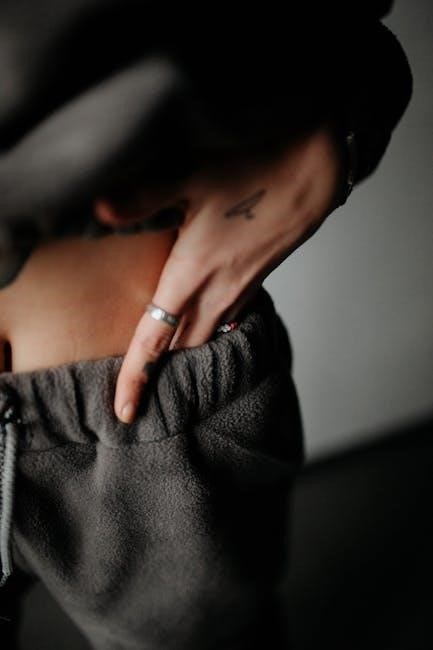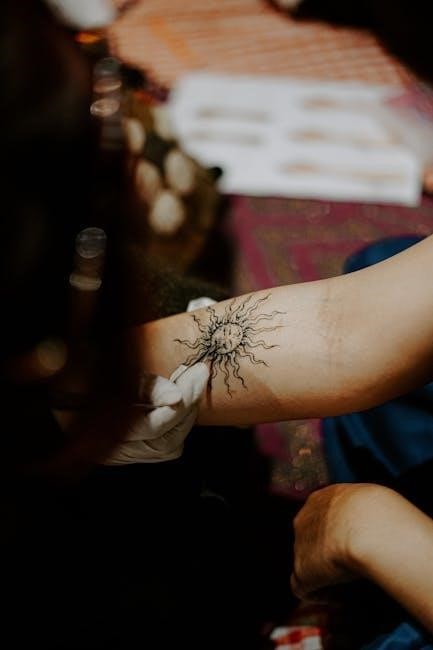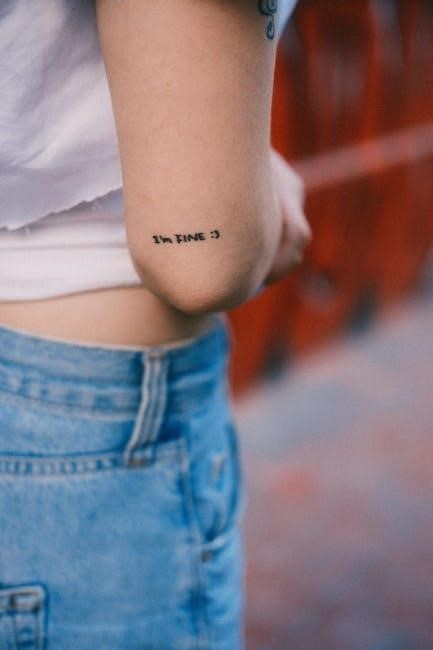Welcome to our Tattoo Placement Guide! Discover how to choose the perfect spot, considering design flow, visibility, and personal style. Your journey starts here!
Importance of Choosing the Right Placement
Choosing the right tattoo placement is crucial for both aesthetic and practical reasons. It ensures your design complements your body’s natural contours and aligns with your personal style. Visibility and privacy are key factors—some placements are easily concealed, while others make a bold statement. Placement also affects how your tattoo ages, with areas exposed to UV light or frequent movement more prone to fading or distortion. Additionally, societal perceptions and workplace policies often influence placement decisions. Pain levels vary by area, and healing times differ based on location. Selecting the right spot ensures your tattoo remains vibrant and meaningful over time. Ultimately, careful consideration of these elements helps you make a decision you’ll love for years to come.
Overview of Key Considerations
When deciding on tattoo placement, several key factors come into play. Design compatibility with body contours ensures a visually appealing outcome, while balancing symmetry can enhance the overall look. Pain tolerance varies across different body areas, influencing placement choices. Healing time and aftercare requirements also differ, with high-friction areas needing extra attention. Societal perceptions and workplace policies may impact visibility preferences. Considering these elements helps in making a well-informed decision, ensuring your tattoo aligns with your lifestyle and personal preferences. By evaluating these aspects, you can choose a placement that not only looks great but also fits seamlessly into your life. A thoughtful approach ensures your tattoo remains a cherished and meaningful expression of your identity.

Considerations Before Choosing a Tattoo Placement
Choosing the right tattoo placement involves considering visibility, personal style, lifestyle, and workplace implications. It also affects pain levels, healing time, and societal perceptions, ensuring a harmonious fit.
Visibility and Privacy Concerns
Visibility and privacy are crucial factors in choosing a tattoo placement. If you prefer discretion, consider hidden areas like behind the ear, between fingers, or on the ribs. These spots allow you to conceal your tattoo easily with clothing, making it suitable for professional environments or personal preference. On the other hand, visible placements such as the forearm, neck, or ankle can make a bold statement. Assessing your lifestyle and workplace policies is essential, as visible tattoos may impact career opportunities. Additionally, consider how your tattoo will look over time, as areas exposed to UV light or frequent movement may fade or distort. Balancing your desire for self-expression with practical concerns ensures a decision you’ll be comfortable with long-term.
Personal Style and Aesthetic Preferences
Your personal style and aesthetic preferences play a significant role in selecting a tattoo placement. For instance, delicate designs often suit smaller, more discreet areas like the wrist or behind the ear, while bold, intricate art may look stunning on larger canvases such as the back or chest. Consider how the tattoo will complement your body shape and natural lines; Symmetrical placements, like mirroring designs on both arms or calves, can enhance balance and visual appeal. Additionally, reflect on your wardrobe and how the tattoo will interact with your clothing choices. For those who prefer minimalist fashion, a hidden tattoo might be ideal, whereas statement pieces can complement edgy or bohemian styles. Ultimately, your tattoo should harmonize with your unique identity and personal taste, creating a seamless blend of art and self-expression.

Lifestyle and Workplace Implications
Lifestyle and workplace implications are vital considerations when choosing a tattoo placement. Many careers require tattoos to be covered, especially in conservative industries like healthcare or finance. Visible placements, such as hands, neck, or face, may limit job opportunities or require constant concealment. Conversely, tattoos in discreet areas like the forearm or shoulder can be easily hidden with clothing. For those with active lifestyles, high-friction areas like the elbows or knees may not be ideal due to potential wear and tear. Additionally, individuals who frequent beaches or pools might prefer placements that won’t be constantly exposed to sun or water, minimizing fading and damage. Balancing personal expression with professional and social demands ensures your tattoo enhances your life without causing unnecessary challenges.
Popular Tattoo Placement Ideas
Discover trendy and timeless spots for your ink. Explore small, medium, large, and extra-large placements that suit your style and body contours for a flawless look.
Small Tattoo Placements
Small tattoos are perfect for subtle, meaningful designs. Popular spots include the wrist, behind the ear, and between the fingers. These areas allow for delicate details and easy concealment. For minimalists, a small tattoo can be both elegant and discreet, making it ideal for those who prefer understated body art. The wrist, for instance, offers a canvas for dainty symbols or letters, while the area behind the ear is great for tiny motifs that add a personal touch without being overly visible. Between the fingers, a small tattoo can serve as a hidden gem, offering privacy and uniqueness. These placements are versatile, complementing various personal styles while maintaining a low profile.
Medium Tattoo Placements
Medium tattoos offer a balanced approach, providing enough space for detailed designs without overwhelming the body. Popular placements include the forearm, calf, or upper back, where the art can naturally flow with the body’s contours. These areas allow for intricate details while remaining manageable in size. A medium-sized tattoo on the forearm, for instance, can showcase bold lines or delicate shading, making it a versatile choice. The calf is another excellent spot, offering a larger canvas for designs like floral patterns or geometric shapes. The upper back is ideal for symmetrical pieces that enhance the body’s natural curves. Medium tattoos strike a perfect balance between visibility and subtlety, making them suitable for various lifestyles and personal styles. They are also adaptable, fitting seamlessly into both professional and casual settings;
Large Tattoo Placements
Large tattoos are ideal for making a bold statement, offering ample space for intricate designs and vibrant details. Popular placements include the back, chest, or thighs, where the canvas is expansive. These areas allow artists to create elaborate scenes, such as sprawling landscapes or detailed portraits. A backpiece, for example, can feature seamless imagery that wraps around the torso, creating a visually striking effect. The chest is another prime location, often used for symbolic or meaningful designs that draw attention to the center of the body. Thighs provide a wide area for dynamic compositions, making them perfect for those who want to showcase their art prominently. Large tattoos require careful consideration of pain levels and healing times, as they cover more skin. Despite the challenges, they offer a unique way to express personal identity and artistry, making them a rewarding choice for committed tattoo enthusiasts.
Extra Large Tattoo Placements
Extra large tattoos are for those seeking a dramatic and transformative piece of body art; These extensive designs often cover significant portions of the body, such as full sleeves, backpieces, or chest-to-stomach wraps. They are ideal for intricate, detailed artwork that tells a story or represents a deep personal journey. Full-body sleeves, for instance, can weave together multiple themes or symbols, creating a cohesive narrative across the arms, legs, or torso. The commitment required for such large-scale tattoos is substantial, both in time and aftercare. Healing times are longer, and maintaining the design’s vibrancy demands careful sun protection. Despite the challenges, extra large tattoos offer unparalleled self-expression, turning the body into a living canvas. They are a testament to the artistry of tattooing and the wearer’s dedication to their personal aesthetic, making them a powerful statement of individuality and creativity.

Factors Influencing Tattoo Placement
Tattoo placement is shaped by pain tolerance, lifestyle, and design aesthetics. Visibility, healing time, and societal perceptions also play crucial roles in deciding where to ink your body.

Pain Levels Associated with Different Areas
Tattoo pain varies significantly depending on the body area. Bony or sensitive regions, like the ribs, feet, and head, tend to be more painful due to less fatty tissue. Areas with more muscle, such as the arms and legs, are generally more comfortable. The neck and hands can be particularly sensitive, while the back and shoulders are often described as manageable. Personal pain tolerance also plays a significant role, as individuals perceive discomfort differently. It’s essential to research and understand the pain levels associated with your desired placement to ensure a smoother tattooing experience. Some areas may require more breaks during sessions, while others can be completed in one sitting. Understanding pain levels helps in making informed decisions for a pleasant tattoo journey.
How Placement Affects Tattoo Aging
Tattoo placement significantly impacts how your design ages over time. Areas exposed to frequent sun exposure, such as the hands and neck, are more prone to fading due to UV damage. Similarly, tattoos on joints like elbows and knees may distort as skin stretches and moves, causing the ink to spread unevenly. Tattoos on areas with high friction, like the feet or ankles, tend to blur faster. Conversely, tattoos placed on less exposed areas, such as the back or shoulders, generally retain their clarity and vibrancy longer. Proper sun protection and aftercare can mitigate some aging effects, but choosing a placement that complements your lifestyle is key to maintaining your tattoo’s appearance. Understanding these factors ensures your tattoo remains vibrant and intact for years to come.
Societal Perception and Professional Implications
Tattoo placement can significantly influence societal perception and professional opportunities. Visible tattoos in certain industries may raise concerns, while hidden ones are often more accepted; For example, tattoos on the hands, neck, or face are more likely to draw attention and could impact workplace dynamics. However, in creative or artistic fields, visible tattoos may be seen as a form of self-expression. Ultimately, the decision to get a tattoo in a visible area should consider both personal and professional goals. Consulting with a tattoo artist can help ensure the placement aligns with your lifestyle and career aspirations. Balancing individuality with societal expectations is key to making a choice that resonates with your identity and life path.
Healing Time and Aftercare Requirements
Healing time and aftercare requirements vary significantly depending on tattoo placement. Areas with high friction, like elbows or shoulders, tend to heal slower due to constant movement, while low-friction areas, such as calves, heal faster. Proper aftercare is crucial to ensure the tattoo heals well and maintains its vibrancy. Sun exposure can fade tattoos, especially on hands and necks, so sunscreen is essential. For areas like hands or feet, which are prone to wear, extra care is needed to prevent fading. Additionally, certain placements may require avoiding water or tight clothing during healing. Balancing personal style with aftercare needs is key. Consulting a professional can help tailor aftercare routines to specific placements, ensuring optimal results. Remember, proper aftercare is an investment in your tattoo’s longevity and appearance.

Design Considerations for Tattoo Placement
Ensure your tattoo design harmonizes with your body’s natural curves and lines for a seamless look. Balance and symmetry are key to creating visually stunning, cohesive art.
Ensuring Design Flows with Body Contours
When choosing a tattoo placement, it’s crucial to ensure the design complements your body’s natural curves and lines. A well-placed tattoo enhances the visual appeal and creates a harmonious look. For instance, spiral designs can elegantly wrap around arms or legs, while linear patterns may suit straight areas like the spine or forearm. Consider how the tattoo will appear from different angles and how it interacts with surrounding body parts. A skilled artist can help tailor the design to your physique, ensuring it looks stunning and cohesive. This approach not only elevates the tattoo’s aesthetic but also makes it a natural extension of your body.
Balance and Symmetry in Placement
Balance and symmetry play a vital role in tattoo placement, ensuring the design looks visually appealing and harmonious on the body. Symmetrical placements, such as matching tattoos on opposite arms or legs, create a sense of order and elegance. For asymmetrical designs, strategic placement can still achieve balance by considering the body’s natural proportions. For example, a bold tattoo on one side can be offset by a smaller, complementary piece on the other. Additionally, elements like lines, shapes, and negative space can enhance symmetry without mirroring. Balancing placement also involves considering how the tattoo interacts with surrounding areas, ensuring it doesn’t overwhelm or clash with existing body art. Achieving balance ensures the tattoo looks intentional and cohesive, making it a stunning addition to your personal canvas.

Tattoo Placement and Aftercare
Proper aftercare depends on placement; high-friction areas need extra attention, while UV exposure and moisturizing are crucial for optimal healing and tattoo longevity.

Healing Process for Different Body Areas
The healing process varies depending on tattoo placement due to factors like friction, UV exposure, and natural moisture levels. Areas with high friction, such as elbows or hands, may take longer to heal and require extra care. Similarly, tattoos on feet or ankles are prone to irritation from footwear. Tattoos on the neck or sternum heal faster but are more visible during the process. Proper aftercare, including keeping the area clean and moisturized, is essential for all placements. UV exposure can fade ink over time, especially on hands and necks. Each body area has unique challenges, so understanding these differences ensures optimal healing and longevity of your tattoo. Regular moisturizing and sun protection are key to maintaining vibrant designs. By tailoring aftercare routines to specific body areas, you can promote healthier skin and preserve your tattoo’s appearance.
How Placement Impacts Aftercare Routine
Tattoo placement significantly influences the aftercare routine, as different body areas have unique needs. Areas prone to friction, like elbows or hands, require extra protection to prevent irritation. Tattoos on feet or ankles may need bandages to shield from constant contact with shoes. Conversely, tattoos on the neck or sternum are more exposed, necessitating frequent moisturizing to prevent dryness. UV exposure affects placements like hands and necks, requiring diligent sun protection to avoid fading. Additionally, areas with natural moisture, such as the back or chest, may heal faster but need careful cleaning to prevent infections. Tailoring aftercare routines to the specific placement ensures proper healing and maintains the tattoo’s vibrancy. Regular moisturizing, sun protection, and avoiding tight clothing are essential for optimal results. Adjusting your aftercare based on placement helps promote healthy skin and preserves your tattoo’s appearance for years to come. Consistency is key to achieving the best outcome.
Finalizing your tattoo journey begins with the right placement. Consider design, visibility, and personal style. Choose wisely and embrace your art with confidence!
Final Tips for Choosing the Perfect Placement
When selecting the ideal spot for your tattoo, prioritize how it complements your body’s natural curves and personal style. Consider the design’s size and how it aligns with your lifestyle. Reflect on visibility—do you prefer a discreet or eye-catching piece? Balance and symmetry are key for a visually appealing result. Think about long-term implications, such as UV exposure and aging, which can affect the tattoo’s appearance over time. Pain tolerance is another factor, as certain areas are more sensitive. Lastly, ensure proper aftercare routines based on the placement to promote healing. Take your time and collaborate with your artist to create a meaningful, timeless piece that resonates with you.
Encouragement for Responsible Tattoo Decisions
Taking the time to thoughtfully decide on your tattoo placement ensures a design that truly reflects your identity. Remember, a tattoo is a lifelong commitment, so prioritize quality over impulse. Research reputable artists whose styles align with your vision, and engage in open communication to bring your ideas to life. Consider your personal and professional life when choosing visibility, as this can impact societal perceptions. Reflect on how your tattoo will age and the care it will require. By approaching your decision with mindfulness and responsibility, you’ll create a meaningful piece that brings lasting joy. Embrace the process, and let your tattoo become a testament to your unique journey.